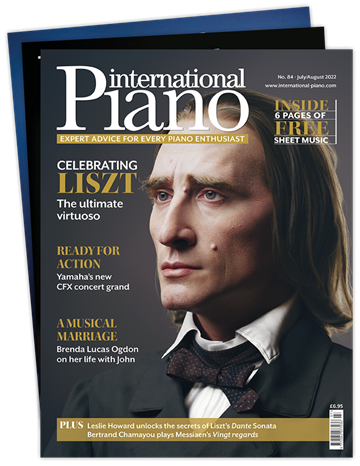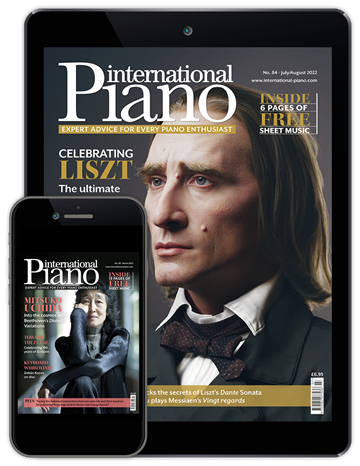George Li: an invitation to dance
George Li
Friday, August 30, 2024
George Li introduces his new album of dance‑related works by Ravel, Schumann and Stravinsky and explores what binds these pieces into a cohesive programme

It is frequently said that the process of recording a studio album is a painstaking and hellish one, requiring the artist to be at their most vulnerable, all the while recording, dissecting, cringing and re-recording until it reaches a satisfactory standard. While I must admit the process for me included all of these things, I have also carried a feeling of immense pride and a sense of fulfilment throughout this journey, a surging sensation that feels foreign to me.
The inception of this album began from its early seeds in the middle of the pandemic, when I first started considering making a recording based on the theme of ‘dances’. I wanted to create a programme that felt cohesive, a programme that could lead the listener through a journey of discovery. To me, recital programmes are like personal essays, much like this article – a window into the mind of the artist, where the listener can find solace in their thoughts, feelings and ideas while momentarily escaping a frenetic and chaotic society. This cohesion came through the form of dance suites from Schumann, Ravel and Stravinsky. On the surface, these composers may not have much in common, but I believe that the Schumann pieces in particular set the framework for the rest of the programme.
Schumann has been a composer I have studied intensely over the past several years and I so cherish his music. I have a personal connection to his works partly due to my own studies of English literature, particularly the Romantics. Studying the great classics, and especially English Romantic poetry, has deepened my understanding and curiosity of the musical language and drawn me closer to pieces like Schumann’s Arabeske and Davidsbündlertänze. In the Arabeske – while being exceedingly beautiful in its simplicity and gentle water-like textures in the opening sections – there are several indicators of what’s to come, particularly in the tension of contrasting moods and characters, and the loosened but ever-present structure that holds musical moments together. Schumann uses the form of the rondo to contain the ideas of the Arabeske, but within this basic form the listener is exposed to such vulnerable contrasting feelings – confessions of love, quickly followed by feelings of yearning and torment. Yet the piece ends with such aching and moving tenderness, perhaps looking back at one’s childhood with a simplistic beauty, which to me speaks as a smaller reflection of the Davidsbündlertänze within the context of this programme.
What follows is a roller coaster of a journey for the next 37 minutes; to me, the Davidsbündlertänze is one of Schumann’s greatest musical cycles. Schumann is known for his sensitive and ever-changing personalities, which shine brightest in this dance-cycle form – he often personifies his two major contrasting characters as Florestan and Eusebius. In fact, within this work, Schumann explicitly writes out ‘F.’ or ‘E.’ at the end of each dance to signify which character he’s striving for, and some dances even contain both characters conversing with each other. Although composed as a set of dances, I find it helpful to visualise the trajectory of the piece through the lens of lieder – the German art-song form that Schubert and Schumann himself perfected. In doing so, it becomes easier to find an architectural narrative. For me, the biggest interpretative challenge is to give space for each musical moment to be its own distinct individual voice while also maintaining the narrative arc. Schumann gives clues on how to do this in various ways – one is through the two major harmonic centres grounding the piece: G major and B minor. Around these two keys, Schumann builds a tonal universe akin to Schubert’s harmonic language: a network of related keys departing from traditional classical structural rules. By doing so, Schumann creates a vast universe of tonal colour, giving him the tools to portray the long journey of emotional and character shifts within this piece.
On several occasions, Schumann even links subsequent pieces (in different keys) together through a shared note, a literal single strand that transforms the mood with a harmonic shift. To go even further with the connected strands, he repeats the second dance in its entirety just after the penultimate ‘lied’ in B major, bringing the piece full circle and returning in its entirety, but at the same time as a changed entity. After experiencing the full range of characters and human emotions, the sorrowful theme is felt with even more emptiness, as the anguish and torment rise to a climax by the coda. These are all ways in which Schumann allows the performer to guide the listener to both thoroughly absorb and enjoy the fragmented yet beautiful nature of his wandering fantasies while also achieving momentum and ultimate catharsis once the comforting and moving ending arrives, as the bells toll goodnight.
Ravel emulates Schumann’s cyclical nature in his Valses nobles et sentimentales. This set of pieces is so gorgeous in terms of their colour and textural palette, as he blends beguiling harmonies with warm yet transparent textures. Although the waltzes’ rhythmic pattern is consistently present in the left hand, the harmonic and melodic writing constantly stretches the limit of the pulse, giving the sensation that both are bending in sound and time.
Like Schumann, Ravel on several occasions links pieces together with a singular strand, which melts into the character of the following waltz. And as in the Davidsbündlertänze, Ravel’s penultimate movement repeats elements heard before. However, Ravel transforms the movement into a true ballroom-style waltz, deriving from the three questioning iterations of the main motif of the previous dance while slowly transforming into the theme of the new one, a waltz that seemingly anticipates La valse. And the final piece is a haunting, mysterious summation of all the preceding dances: here Ravel echoes Schumann as he inserts ghostly remnants of the previous motifs, saying farewell to a glorious age of elegance and opulence.
Finally, out of the silence of G major, the famous dance of the puppets in the village rings out in full force (coincidentally, the same first harmony as the Ravel) in the opening measures of Stravinsky’s Petrushka. Even in this work, strands are a commonality with the rest of the programme – the famous ‘Petrushka chord’ appears as a motif in different forms throughout. While certainly being an ultra-virtuosic piece, it is the variety of colour and texture that attracts me to it. Throughout this work, Stravinsky is so vivid in his portrayal of characters and the village, as if inserting the listener into the scene itself.
In the second movement, one can visualise Petrushka being banished to his room by the wizard, suffering in agony while yearning to be with his unrequited love – all described through Stravinsky’s use of silence, creative harmonic and motivic units, and enchanting textures. Even in the first dance, the main motifs maintain clarity and supremacy, but underneath, the textures and harmonies are constantly changing and bubbling from within, propelling the listener into the rustic scene of the Russian village as Petrushka and the puppets burst alive with their dancing. And the final movement to me is one extended crescendo of build-ups. As Stravinsky continuously shifts between folk dances and characters through the village, an increase of urgency and frenzied chaos develops in the undercurrents, reaching a fevered pitch in the coda that doesn’t let up until the thrilling climax, as the listener is finally rewarded with the final iteration of the Petrushka chord.
I see this programme as an evolution of sorts, as the music progresses from a very intimate state of being – the Schumann and the Arabeske in particular seem to be written for an audience of one (Clara), fortified by the connotations and connections of Schubert, lieder and the solo piano – to one that is fully externalised, with vivid sound worlds of ballet, orchestral instrumentation and rustic dance. I’m very grateful to Warner Classics for entrusting me with the artistic freedom within such a wonderful genre of music, and I’m so looking forward to sharing with you the fruit that has blossomed out of those seeds I initially planted more than two years ago.
This article originally appeared in the Autumn 2024 issue of International Piano. Never miss an issue – subscribe today












